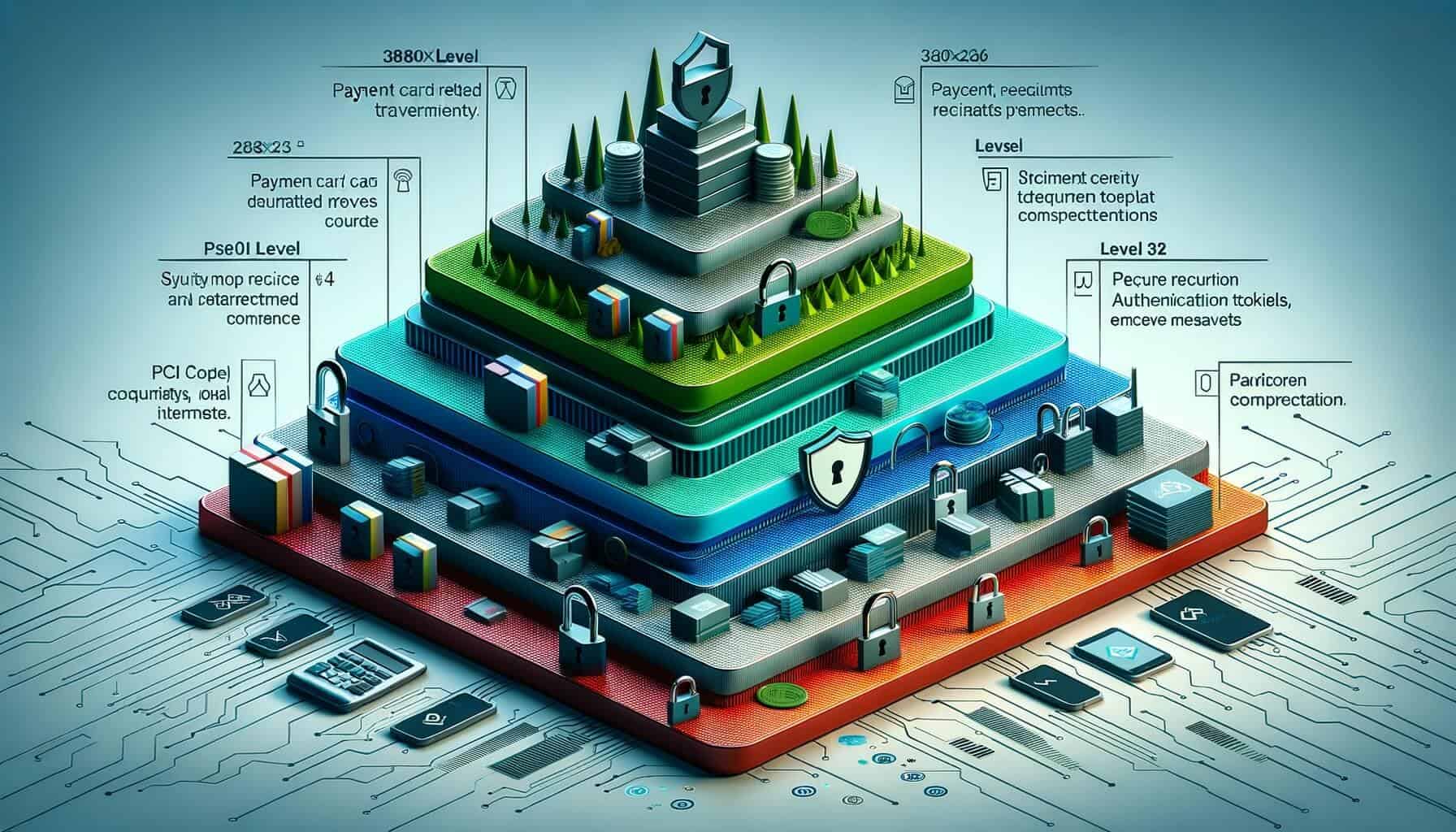
By American February 4, 2025
In today’s digital age, where online transactions have become the norm, ensuring the security of sensitive payment card information is of utmost importance. This is where PCI compliance comes into play. PCI compliance, or Payment Card Industry compliance, refers to the set of security standards established by the Payment Card Industry Security Standards Council (PCI SSC) to protect cardholder data and prevent fraud.
In this article, we will delve into the four levels of PCI compliance, providing a comprehensive guide to understanding and achieving compliance.
Understanding the Four Levels of PCI Compliance
PCI compliance is not a one-size-fits-all approach. The PCI SSC has categorized businesses into four levels based on their annual transaction volume. Each level has its own set of requirements and obligations to achieve and maintain compliance. Let’s take a closer look at each level:
Level 1 PCI Compliance: What it Means and Who Needs it
Level 1 PCI compliance is the highest level of compliance and is required for businesses that process a large volume of transactions or have experienced a data breach in the past. This level of compliance is applicable to merchants who process over 6 million transactions annually. Achieving level 1 compliance involves undergoing a thorough assessment by a Qualified Security Assessor (QSA) and submitting a Report on Compliance (ROC) to the acquiring bank. The assessment includes a review of the merchant’s network architecture, policies, procedures, and security controls.
To meet the requirements of level 1 PCI compliance, businesses must implement robust security measures such as maintaining a secure network, regularly monitoring and testing their systems, and implementing strong access control measures. Additionally, they must conduct regular vulnerability scans and penetration tests to identify and address any potential vulnerabilities in their systems.
Level 2 PCI Compliance: Requirements and Best Practices
Level 2 PCI compliance is applicable to merchants who process between 1 million and 6 million transactions annually. While the requirements for level 2 compliance are similar to level 1, the assessment process is less rigorous. Merchants at this level are required to complete a Self-Assessment Questionnaire (SAQ) and undergo quarterly network vulnerability scans conducted by an Approved Scanning Vendor (ASV).
To achieve level 2 compliance, businesses must implement measures such as maintaining a firewall configuration, encrypting cardholder data, and regularly updating their systems to address any known vulnerabilities. They must also ensure that their employees are trained on security best practices and that access to cardholder data is restricted to authorized personnel only.
Level 3 PCI Compliance: Simplifying Compliance for Mid-sized Businesses
Level 3 PCI compliance is designed for mid-sized businesses that process between 20,000 and 1 million transactions annually. This level of compliance aims to simplify the compliance process for these businesses while still ensuring the security of cardholder data. To achieve level 3 compliance, merchants must complete a SAQ and undergo quarterly network vulnerability scans.
In addition to the requirements for level 2 compliance, level 3 merchants must implement measures such as maintaining an inventory of system components, implementing secure coding practices, and regularly testing their systems for vulnerabilities. They must also ensure that any third-party service providers they work with are also PCI compliant.
Level 4 PCI Compliance: Streamlining Compliance for Small Businesses
Level 4 PCI compliance is applicable to small businesses that process fewer than 20,000 transactions annually. This level of compliance aims to streamline the compliance process for these businesses, recognizing their limited resources and capabilities. To achieve level 4 compliance, merchants must complete a SAQ and undergo quarterly network vulnerability scans.
While the requirements for level 4 compliance are less stringent compared to the higher levels, small businesses must still implement measures such as maintaining a secure network, encrypting cardholder data, and regularly monitoring and testing their systems. They must also ensure that any payment applications they use are validated as compliant with the PCI DSS.
Key Requirements for Achieving PCI Compliance
Regardless of the level of compliance, there are key requirements that businesses must meet to achieve PCI compliance. These requirements are outlined in the PCI DSS, which is a set of security standards established by the PCI SSC. The PCI DSS consists of 12 requirements that cover various aspects of security, including network security, access control, and encryption.
Some of the key requirements include:
1. Building and maintaining a secure network: This involves installing and maintaining a firewall configuration to protect cardholder data and ensuring that default passwords and security settings are changed.
2. Protecting cardholder data: This requires encrypting cardholder data both in transit and at rest, as well as implementing strong access control measures to restrict access to cardholder data.
3. Regularly monitoring and testing systems: This involves regularly monitoring and testing systems for vulnerabilities, as well as conducting penetration tests and vulnerability scans.
4. Implementing strong access control measures: This includes assigning a unique ID to each person with computer access, restricting physical access to cardholder data, and implementing two-factor authentication for remote access.
5. Maintaining an information security policy: This requires developing and maintaining a comprehensive information security policy that addresses all aspects of security and is communicated to all employees.
Understanding the PCI DSS (Payment Card Industry Data Security Standard)
The PCI DSS, or Payment Card Industry Data Security Standard, is a set of security standards established by the PCI SSC to protect cardholder data and prevent fraud. The PCI DSS consists of 12 requirements that businesses must meet to achieve compliance. These requirements cover various aspects of security, including network security, access control, and encryption.
The 12 requirements of the PCI DSS are as follows:
1. Install and maintain a firewall configuration to protect cardholder data.
2. Do not use vendor-supplied defaults for system passwords and other security parameters.
3. Protect stored cardholder data through encryption.
4. Encrypt transmission of cardholder data across open, public networks.
5. Use and regularly update anti-virus software or programs.
6. Develop and maintain secure systems and applications.
7. Restrict access to cardholder data by business need-to-know.
8. Assign a unique ID to each person with computer access.
9. Restrict physical access to cardholder data.
10. Track and monitor all access to network resources and cardholder data.
11. Regularly test security systems and processes.
12. Maintain a policy that addresses information security for all personnel.
By adhering to these requirements, businesses can ensure the security of cardholder data and achieve PCI compliance.
Common Challenges and Pitfalls in Achieving PCI Compliance
Achieving PCI compliance can be a complex and challenging process, with several common challenges and pitfalls that businesses may encounter. Some of these challenges include:
1. Lack of awareness: Many businesses are not fully aware of the importance of PCI compliance or the steps required to achieve it. This lack of awareness can lead to non-compliance and increased risk of data breaches.
2. Limited resources: Achieving and maintaining PCI compliance requires dedicated resources, including time, personnel, and financial investment. Small businesses, in particular, may struggle with limited resources, making compliance more challenging.
3. Complexity of requirements: The requirements of the PCI DSS can be complex and technical, requiring businesses to have a deep understanding of security best practices and technologies. This complexity can make it difficult for businesses to implement the necessary security measures.
4. Changing threat landscape: The threat landscape is constantly evolving, with new vulnerabilities and attack vectors emerging regularly. Staying up to date with the latest security threats and implementing appropriate measures to mitigate these risks can be a challenge for businesses.
5. Non-compliant third-party service providers: Many businesses rely on third-party service providers for various aspects of their operations, including payment processing. However, if these service providers are not PCI compliant, it can pose a risk to the security of cardholder data.
To overcome these challenges and pitfalls, businesses should prioritize PCI compliance and allocate the necessary resources to achieve and maintain compliance. This may involve investing in security technologies, training employees on security best practices, and regularly assessing and updating security measures.
Frequently Asked Questions (FAQs)
Q1. What is PCI compliance?
PCI compliance refers to the set of security standards established by the PCI SSC to protect cardholder data and prevent fraud. It is mandatory for businesses that process, store, or transmit payment card information.
Q2. Who needs to be PCI compliant?
Any business that accepts payment cards, regardless of size or industry, needs to be PCI compliant. The level of compliance required depends on the volume of transactions processed annually.
Q3. What are the consequences of non-compliance?
Non-compliance with PCI standards can result in severe consequences, including fines, penalties, loss of reputation, and increased risk of data breaches.
Q4. How can I achieve PCI compliance?
To achieve PCI compliance, businesses must meet the requirements outlined in the PCI DSS. This involves implementing robust security measures, regularly monitoring and testing systems, and undergoing assessments by a QSA or completing a SAQ.
Q5. How often do I need to undergo PCI compliance assessments?
The frequency of PCI compliance assessments depends on the level of compliance required. Level 1 and level 2 merchants are required to undergo annual assessments, while level 3 and level 4 merchants are required to undergo assessments every two years.
Conclusion
In today’s digital landscape, where cyber threats are on the rise, ensuring the security of cardholder data is crucial. PCI compliance provides a framework for businesses to protect sensitive payment card information and prevent fraud. By adhering to the requirements outlined in the PCI DSS and achieving the appropriate level of compliance, businesses can mitigate the risk of data breaches, protect their reputation, and maintain the trust of their customers.
To achieve PCI compliance, businesses should start by understanding the basics of PCI compliance and the different levels of compliance. They should then assess their current security measures and identify any gaps or vulnerabilities. By implementing the necessary security measures, regularly monitoring and testing systems, and staying up to date with the latest security threats, businesses can achieve and maintain PCI compliance.
It is important to note that achieving PCI compliance is not a one-time task but an ongoing process. Businesses must continuously assess and update their security measures to address new threats and vulnerabilities. By prioritizing PCI compliance and investing in the necessary resources, businesses can ensure the security of cardholder data and protect their bottom line.



